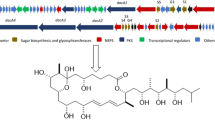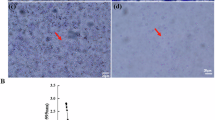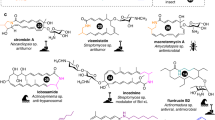Abstract
Erythromycin and related macrolide antibiotics are widely used polyketide natural products. We have evolved an engineered biosynthetic pathway in Escherichia coli that yields erythromycin analogs from simple synthetic precursors. Multiple rounds of mutagenesis and screening led to the identification of new mutant strains with improved efficiency for precursor-directed biosynthesis. Genetic and biochemical analysis suggested that the phenotypically relevant alterations in these mutant strains were localized exclusively to the host-vector system, and not to the polyketide synthase. We also demonstrate the utility of this improved system through engineered biosynthesis of a novel alkynyl erythromycin derivative with comparable antibacterial activity to its natural counterpart. In addition to reinforcing the power of directed evolution for engineering macrolide biosynthesis, our studies have identified a new lead substance for investigating structure–function relationships in the bacterial ribosome.
Similar content being viewed by others

Log in or create a free account to read this content
Gain free access to this article, as well as selected content from this journal and more on nature.com
or
References
Cane, D. E., Walsh, C. T. & Khosla, C. Harnessing the biosynthetic code: combinations, permutations, and mutations. Science 282, 63–68 (1998).
Khosla, C., Gokhale, R. S., Jacobsen, J. R. & Cane, D. E. Tolerance and specificity of polyketide synthases. Annu. Rev. Biochem. 68, 219–253 (1999).
Tenover, F. C. et al. Vancomycin-resistant Staphylococcus aureus isolate from a patient in Pennsylvania 48, 275–280 (2004).
Walsh, C. T. Polyketide and nonribosomal peptide antibiotics: modularity and versatility. Science (New York, N.Y) 303, 1805–1810 (2004).
Jacobsen, J. R., Hutchinson, C. R., Cane, D. E. & Khosla, C. Precursor-directed biosynthesis of erythromycin analogs by an engineered polyketide synthase. Science (New York, N.Y) 277, 367–369 (1997).
Cane, D. E., Kudo, F., Kinoshita, K. & Khosla, C. Precursor-directed biosynthesis: biochemical basis of the remarkable selectivity of the erythromycin polyketide synthase toward unsaturated triketides. Chem. Biol. 9, 131–142 (2002).
Boddy, C. N., Hotta, K., Tse, M. L., Watts, R. E. & Khosla, C. Precursor-directed biosynthesis of epothilone in Escherichia coli 126, 7436–7437 (2004).
Elliott, R. L. et al. Anhydrolide macrolides. 1. Synthesis and antibacterial activity of 2,3-anhydro-6-O-methyl 11,12-carbamate erythromycin A analogues. J. Med. Chem. 41, 1651–1659 (1998).
Sheehan, L. S. et al. Engineering of the spinosyn PKS: directing starter unit incorporation 69, 1702–1710 (2006).
Donadio, S., McAlpine, J. B., Sheldon, P. J., Jackson, M. & Katz, L. An erythromycin analog produced by reprogramming of polyketide synthesis 90, 7119–7123 (1993).
Jacobsen, J. R., Keatinge-Clay, A. T., Cane, D. E. & Khosla, C. Precursor-directed biosynthesis of 12-ethyl erythromycin. Bioorg. Med. Chem. 6, 1171–1177 (1998).
Dayem, L. C. et al. Metabolic engineering of a methylmalonyl-CoA mutase-epimerase pathway for complex polyketide biosynthesis in Escherichia coli. Biochemistry 41, 5193–5201 (2002).
Lowden, P. A., Bohm, G. A., Metcalfe, S., Staunton, J. & Leadlay, P. F. New rapamycin derivatives by precursor-directed biosynthesis. Chembiochem. 5, 535–538 (2004).
Kinoshita, K., Williard, P. G., Khosla, C. & Cane, D. E. Precursor-directed biosynthesis of 16-membered macrolides by the erythromycin polyketide synthase. J. Am. Chem. Soc. 123, 2495–2502 (2001).
Frykman, S., Leaf, T., Carreras, C. & Licari, P. Precursor-directed production of erythromycin analogs by Saccharopolyspora erythraea. Biotechnol. Bioeng. 76, 303–310 (2001).
Kinoshita, K., Pfeifer, B. A., Khosla, C. & Cane, D. E. Precursor-directed polyketide biosynthesis in Escherichia coli. Bioorg. Med. Chem. Lett. 13, 3701–3704 (2003).
Lee, H. Y. & Khosla, C. Bioassay-guided evolution of glycosylated macrolide antibiotics in Escherichia coli. PLoS. Biol. 5, e45 (2007).
Peiru, S., Menzella, H. G., Rodriguez, E., Carney, J. & Gramajo, H. Production of the potent antibacterial polyketide erythromycin C in Escherichia coli. Appl. Environ. Microbiol. 71, 2539–2547 (2005).
Pfeifer, B., Hu, Z., Licari, P. & Khosla, C. Process and metabolic strategies for improved production of Escherichia coli-derived 6-deoxyerythronolide B. Appl. Environ. Microbiol. 68, 3287–3292 (2002).
Pfeifer, B. A. & Khosla, C. Biosynthesis of polyketides in heterologous hosts. Microbiol. Mol. Biol. Rev. 65, 106–118 (2001).
Leaf, T. et al. Precursor-directed biosynthesis of 6-deoxyerythronolide B analogs in Streptomyces coelicolor: understanding precursor effects. Biotechnol. Prog. 16, 553–556 (2000).
Greener, A., Callahan, M. & Jerpseth, B. An efficient random mutagenesis technique using an E. coli mutator strain. Mol. Biotechnol. 7, 189–195 (1997).
Novick, R. P. Plasmid incompatibility. Microbiol. Rev. 51, 381–395 (1987).
Nordstrom, K. & Austin, S. J. Mechanisms that contribute to the stable segregation of plasmids. Annu. Rev. Genet. 23, 37–69 (1989).
Austin, S. & Nordstrom, K. Partition-mediated incompatibility of bacterial plasmids. Cell 60, 351–354 (1990).
Smith, M. A. & Bidochka, M. J. Bacterial fitness and plasmid loss: the importance of culture conditions and plasmid size. Can. J. Microbiol. 44, 351–355 (1998).
Arini, A., Tuscan, M. & Churchward, G. Replication origin mutations affecting binding of pSC101 plasmid-encoded Rep initiator protein. J. Bacteriol. 174, 456–463 (1992).
Kolb, H. C., Finn, M. G. & Sharpless, K. B. Click chemistry: diverse chemical function from a few good reactions. Angew. Chem. Int. Ed. Engl. 40, 2004–2021 (2001).
Rostovtsev, V. V., Green, L. G., Fokin, V. V. & Sharpless, K. B. A stepwise huisgen cycloaddition process: copper(I)-catalyzed regioselective ‘ligation’ of azides and terminal alkynes. Angew. Chem. Int. Ed. Engl. 41, 2596–2599 (2002).
Himo, F. et al. Copper(I)-catalyzed synthesis of azoles. DFT study predicts unprecedented reactivity and intermediates. J. Am. Chem. Soc. 127, 210–216 (2005).
Acknowledgements
This research was supported by grants from the National Institutes of Health to C.K. (GM 087934) and D.E.C. (GM 22172). C.J.B.H. is supported by a fellowship from the Stanford Center for Molecular Analysis and Design (CMAD).
Author information
Authors and Affiliations
Corresponding author
Additional information
Dedicated to the late Dr C Richard Hutchinson for his exceptional contributions to natural product biosynthesis, engineering, and drug discovery.
Supplementary Information accompanies the paper on The Journal of Antibiotics website
Supplementary information
Rights and permissions
About this article
Cite this article
Lee, H., Harvey, C., Cane, D. et al. Improved precursor-directed biosynthesis in E. coli via directed evolution. J Antibiot 64, 59–64 (2011). https://doi.org/10.1038/ja.2010.129
Received:
Revised:
Accepted:
Published:
Issue date:
DOI: https://doi.org/10.1038/ja.2010.129
Keywords
This article is cited by
-
Engineering actinomycetes for biosynthesis of macrolactone polyketides
Microbial Cell Factories (2019)
-
Technical Advances to Accelerate Modular Type I Polyketide Synthase Engineering towards a Retro-biosynthetic Platform
Biotechnology and Bioprocess Engineering (2019)
-
Harnessing natural product assembly lines: structure, promiscuity, and engineering
Journal of Industrial Microbiology and Biotechnology (2016)


